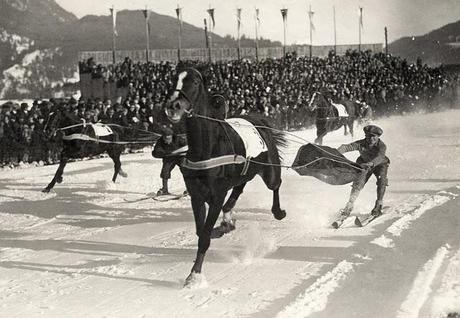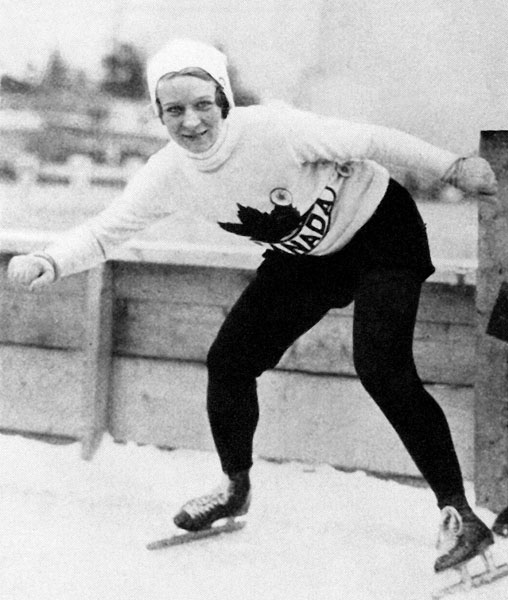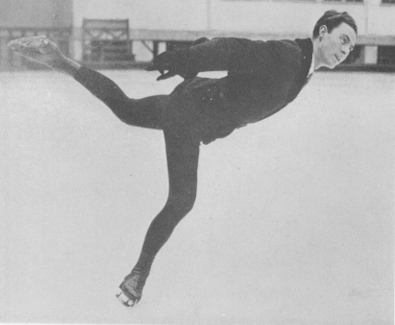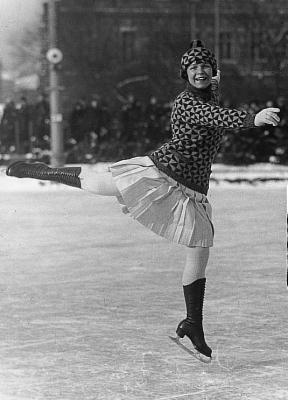In the run up to London 2012 I did a series looking back at all
the previous Olympics posting it at 5pm every Friday, I've decided to do
the same in the run up to Sochi 2014 with the Winter Olympic Games. You
can catch up on any you missed in the Olympiads Revisited tab.
In 1925, following the success of the week of winter sport in Chamonix, the International Olympic Committee decided that every four years there should be a Winter Olympic Games, entirely separate from the Summer Games. Chamonix was retrospectively called the First of these Winter Olympiads. As Amsterdam had already been selected to host the
1928 Summer Games they were given the first refusal to host what were now the Winter Games. But the lack of Alpine landscape and guaranteed cold weather meant that they turned down the offer.
Switzerland were approached and nominated three possible hosts. Davos, Engelberg and St. Moritz. At the 25th IOC congress is Lisbon, St. Moritz were chosen to the first city to host what was to be known before it took part as the Winter Olympic Games.
Competitors 464 (+206)
Nations 25 (+9)
Events 14 (-2)
Sports 4 (-2)
11 February - 19 February, 1928 hosted by St. Moritz, Switzerland
The new nations
The number of nations had increased by more 50% with these games now being an official part of the Olympic movement. The newcomers included the first Winter Olympic delegation from the Southern Hemisphere in the shape of Argentina, as well as Mexico, Estonia, Germany, Japan, Lithuania, Luxembourg, Netherlands and Romania.
Of the new nations only Germany managed to win a medal, although they had sent the largest delegation of competitors to the Games with 44 they only received a bronze in the five man (as it was at the time) bobsleigh. Argentina managed to finish in both 4th and 5th in the 5 man bobsleigh.
From gold to war dead
In that five man bob there was a young driver who at only sixteen was to be the youngest gold medallist in any event until 1992.
Billy Fiske was born in New York but was at school in France in 1924 when he came across the world of bob-sledding. Four years latter he was the driver of USA II who bet their compatriots in USA I by 1.5 seconds. Fiske drove his sled went fastest on the first run, but despite the other USA team going faster on the second of the two runs they were able to hang on to their lead, along with his teams mates Clifford, Grey, Geoffrey Mason, Richard Parke and Nion Tocker.
Four years later in his home Games at Lake Placid Fiske repeated his gold medal winning performance in the now four man bob, again with Grey, but alongside Eddie Eagan and Jay O'Brien.
He was invited to lead the bobsled team in 1936 at Garmisch-Partenkirchen in Germany, but he refused. Some believe that his refusal was because he didn't agree with the politics of Germany at the time. If so, that may explain why he was one of the seven American volunteers to fly planes in the Battle of Britain. He joined No. 601 Squadron of the RAF on 12 July 1940 after completing his pilot training. On 16 August 1940 along with the rest of the squadron he scrambled from Tangmere in his Hurricane fighter, but after just 15 minutes of flying time a German gunner put a bullet through his fuel tank.
With his hands and ankles badly burnt and his aircraft damaged he headed for home, glided his aircraft over the hedgerow at the edge of the airfield and landed. Although he had to be extracted from the plane by ambulance personnel. Shortly after his fuel tank exploded. He died the following day in hospital in Chichester, and for his funeral his coffin was covered in both the Union Flag and Stars and Stripes. He received the 1939-45 Star with Battle of Britain clasp posthumously. Although he was not the first American born pilot be killed in action, he was the first who was still fully a American citizen and there is a memorial to his service in St. Paul's Cathedral what was unveiled on 4 July 1941.
Finally arrived four years late
 |
| 4 years late Burmeister |
Estonia's flag had flown at the start of the 1924 Games the one representative they were meant to have sent Christfried Burmeister to take part in the speed skating. He was withdrawn by the federation although as the Estonian sports officials did not tell the Olympic organisers their flag still was present at the 1924 Opening even though they did not actually take part.
In 1928 Burmeister was joined by his fellow countryman Aleksnader Mitt in the speed skating events. Burmeister was the better placed in the shorter events 15th in the 500m and 18th in the 1000m, to Mitt's 22nd and 19th positions. But in the 5000m Mitt who was 5 years younger was better placed coming 21st three places better than Burmeister. The 10,000m didn't take place due to the ice on the outdoor lake on which the event was being held melting too much.
Mitt would return in 1936, Estonia did not send a team to the 1932 Games, which would be the last time that Estonian winter sports men would take part in a Winter Olympics under their own flag until 1992 after the break up of the USSR.
Four years older now the darling of the Games
In 1924 an eleven year old from Kristiania, by now back to older name of Oslo, made her Olympic debut. She had been last of the eight women in the figure skating then, having to skate over to the side of the rink
during her routine for directions from her coached. Four years on she had come of age.
Sonja Henie had won the world championships the previous year, when she was 14 the first of her unprecedented ten. It was a split decision on the scoring system of the time 3-2 over the defending Olympic and World Champion Herma Szabo of Germany. Then the three judges who placed Henie first were all Norwegian and the Austrian and German judge had placed Szabo first.
Now at fifteen there was to be no doubt the judges were from Norway, France, GB, Belgium, USA, Austria and Germany, although Szabo did not take part to defend her title. But Henie came first in both the compulsory figures and free skating and finished some distance clear of the battle of the minor medals. While she had a 200 point margin there was only 40 points separating 2nd to 5th. Fritzi Burger of Austria won silver because of better judges placings than Beatrix Loughran of the USA who had scored more points.
Henie would go on to defend her title in 1932 and 1936, Burger would have to look up to her on the top step again in four year time with a second silver.
Clean sweeps in cross-country
The Cross County skiing had two events over 18km and 50km and in both there was one country that stood on the podium, though not the same country for both. In the shorter event it was Norway and the longer discipline saw the Swedes take Gold, Silver and Bronze. In fact such was the Nordic dominence in the event that only Otto Wahl of Germany managed to break in amongst the Norwegians, Swedes and Finns in the top 10, doing so in the 50km.
 |
| Johan Grøttumsbråten |
Johan Grøttumsbråten won the 18km in 1 hour, 37 minutes and 1 second a full two minutes ahead of his fellow countryman Ole Hegge. This was an improvement on his silver from four years previously, that year he also managed bronze in the 50km and Nordic Combined. He was to go on and complete a double in St Moritz winning the Nordic combined, in another Norwegian 1-2-3. In 1932 he would repeat his success in the 18km.
In the 50km Per-Erik Hedlund finished 13 minutes 27 seconds ahead of fellow Swede Gustaf Jonsson who by comparison was a mere 16 seconds ahead of Volger Andersson. The margin of victory by Hedlund has never been beaten, nor has anyone come close to it. In these games in wore a white ski suit and a red had this was to be the uniform of Swedish Nordic skiiers until 1976, before they adopted the traditional national colours of blue and yellow.
When in St. Moritz...do as the Cresta runners do
 |
| The Heaton brothers |
The resort of St. Moritz is famous for its Cresta Run and the daredevils who go down it head first. Indeed Billy Fiske (see above) is one of the champions whose name appears on the board in St. Moritz. So of course the skelton was to appear as an Olympic sport on the famous Cresta Run on both the occasions the Games visited St. Moritz, the other being 1948. It wasn't to become a permanent part of the Olympic calendar until 2002.
The USA were represented by two brothers Jennison and John 'Jack' Heaton, their main challenger came from GB's David Carnegie, 11th Earl of Northesk. Jennison was the older of the brothers by 4 years and had been the driver of USA I in the five-man bob which had lost out to Friske, but on the Cresta run over three runs his aggregate time was 1 second faster than his younger brother. Carnegie ended up a further 2.3 seconds back in bronze.
Jack was to appear in two further games in 1932 he was the driver of USA II in the two-man bob taking bronze and when the Games return to St. Moritz in 1948 he took part again in the skeleton and yet again took silver.
Demonstration events
Once again there was military patrol, the forerunner to the modern event of biathlon, though instead of having full Olympic status was reduced to a demonstration sport. Yet again it was exclusively for military personnel. It was won by four Norwegians who had a interesting diversity of participation in the Olympics. One of their number Ole Reistad was making his second Olympic appearance having already taken part in the Modern Pentathlon at the 1920 Summer Games, coming 14th. Reidar Ødegård
was to also take the bronze medal at these Games in the 18km Cross Country skiing. Another of their team
Ole Stensen would go on to take silver in the Nordic combined at the 1932 Winter Olympics.
 |
| Skijoring on the lake at St. Moritz |
As well as the military patrol there was another demonstration sport at the Games that was making its sole appearance.
The sport of skijoring involves people on skis being pulled behind dogs, horses or some mechanised device. It had developed as military discipline and sport as it was used for speedy military dispatches. For the Games in St. Moritz it was held on a frozen lake with all the competitors starting en masse, without any jumps or obstacles on the course as happens now in similar events in North America. It turned a clean sweep for the host nation Switzerland.
Top of the pile
Norway only had 25 athletes at these Game but were top of the medal table securing 15 medals in total. 6 Gold, 4 Silver and 5 Bronze. Along side Sonja Henie and Johan Grøttumsbråten's double, there were golds for Alf Andersen in ski jumping and in speed skating for Bernt Evensen 500m and Ivar Ballangrud 5000m.
Evensen completed a full set of medals with silver in the 1500m and bronze in the 5000m. Ole Hegge and Reidar Ødegård came behind
Grøttumsbråten in the 18km cross country skiing and Hans Vinjarengen and John Snersrud completed the other sweep of medals behind
Grøttumsbråten in the Nordic combined. The other silver was Sigmund Rund in the ski jumping with speed skaters Ballangrud and Roald Larsen completing the haul with bronzes in the 1500m and 500m respectively.
























